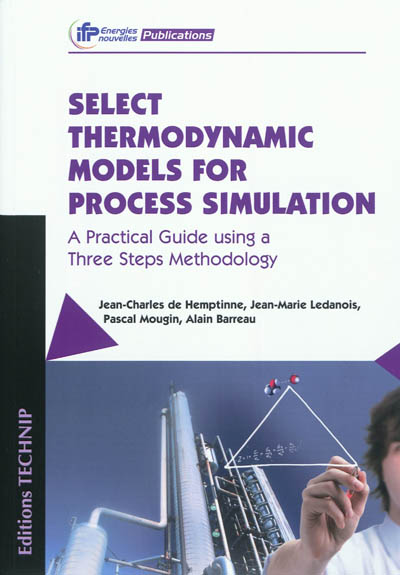en savoir plus

Carte fidélité
Permet à tous ses détenteurs d'obtenir 5% de réduction sur tous les livres lors du retrait en magasin (réduction non cumulable avec les réductions de type étudiant).
Offre également un certain nombre d'avantages auprès de nos partenaires.
Wishlist
Avec les favoris, retrouvez dans un espace les sélections effectuées au fur et à mesure de vos navigations dans le site.
Constituez pour votre usage personnel vos listes de livres en prévisions d'achats futurs et votre sélection d'articles, dossiers, événements, vidéos ou podcasts préférés ou à découvrir plus tard...
Il suffit simplement de cliquer sur "Ajout Favori" sur chaque page qui vous intéresse pour les retrouver ensuite dans votre espace personnel.
Requiert un compte Mollat
Mes Alertes
Requiert un compte Mollat
Select thermodynamic models for process simulation : a practical guide using a three steps methodology
en savoir plus
Résumé
L'ouvrage propose une méthode en 3 étapes permettant à l'ingénieur d'identifier les bonnes questions auxquelles il faut répondre avant de choisir le modèle thermodynamique le plus adéquat à utiliser dans un processus de simulation. ©Electre 2025
Lire la Quatrième de couverture
Réduire la Quatrième de couverture
Select thermodynamic models for process simulation
The selection of the most adequate thermodynamic model in a process simulation is an issue that most process engineer has to face sooner or later.
This book, conceived as a practical guide, aims at providing adequate answers by analysing the questions to be looked at. The analysis (first chapter) yields three keys that are further discussed in three different chapters. (1) A good understanding of the properties required in the process, and their method of calculation is the first key. The second chapter provides to that end in a synthetic manner the most important equations that are derived from the fundamental principles of thermodynamics. (2) An adequate description of the mixture, which is a combination of models and parameters, is the second key. The third chapter makes the link between components and models, both from a numerical (parameterisation) and physical (molecular interactions) point of view. Finally, (3) a correct view of the phase behaviour and trends in regard of the process conditions is the third key. The fourth chapter illustrates the phase behaviour and makes model recommendations for the most significant industrial systems. A decision tree is provided at the end of this chapter. In the last chapter, the key questions are reviewed for a number of typical processes.
This book is intended for process engineers, who are not specialists of thermodynamics but are confronted with this kind of problems and need a reference book, as well as process engineering students who will find an original approach to thermodynamics, complementary of traditional lectures
Fiche Technique
Paru le : 15/05/2012
Thématique : Mécanique
Auteur(s) : Non précisé.
Éditeur(s) :
Technip
Collection(s) : IFP-Institut français du pétrole publications
Contributeur(s) : Auteur : Jean-Charles de Hemptinne - Auteur : Jean-Marie Ledanois - Auteur : Pascal Mougin - Auteur : Alain Barreau
Série(s) : Non précisé.
ISBN : 978-2-7108-0949-4
EAN13 : 9782710809494
Reliure : Broché
Pages : 380
Hauteur: 24.0 cm / Largeur 17.0 cm
Épaisseur: 2.5 cm
Poids: 780 g
